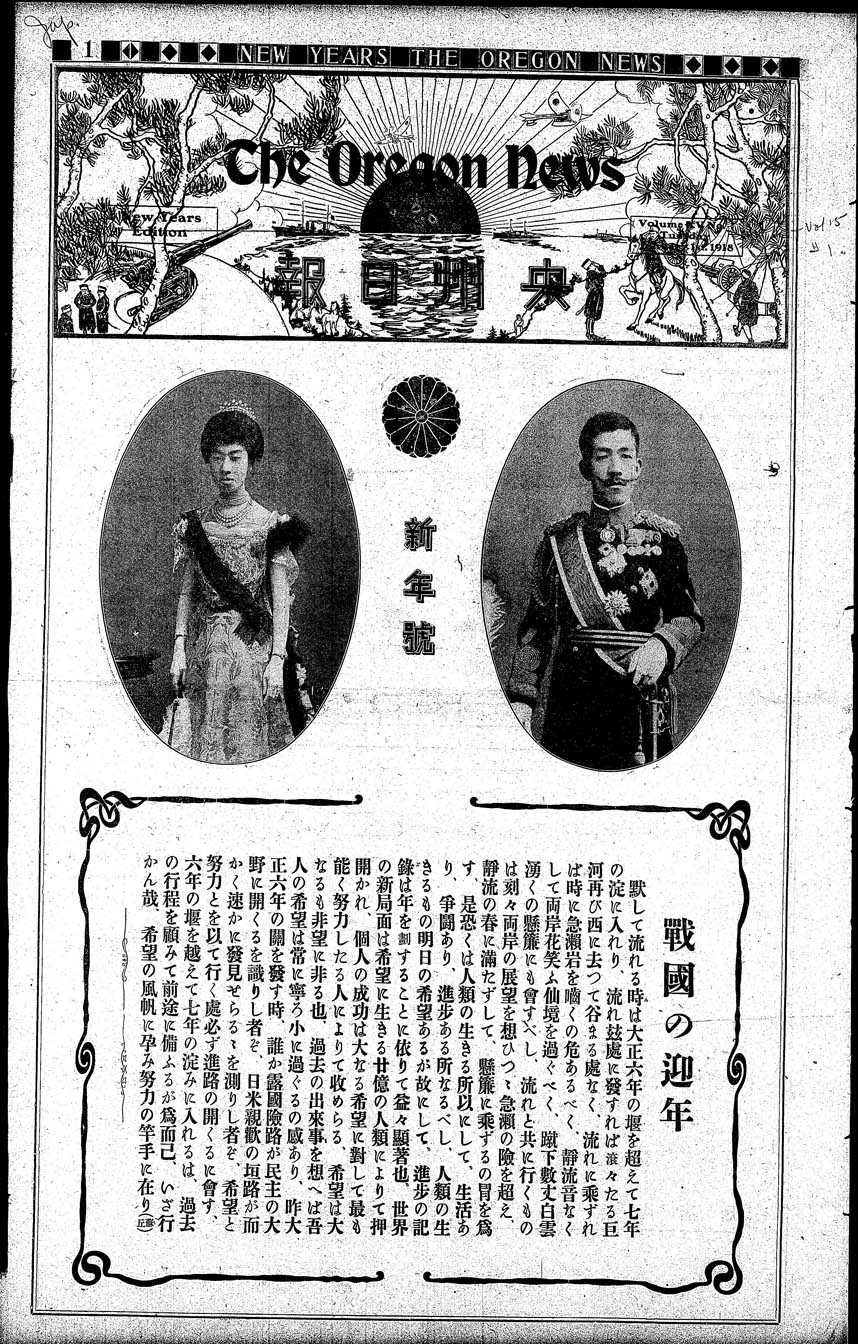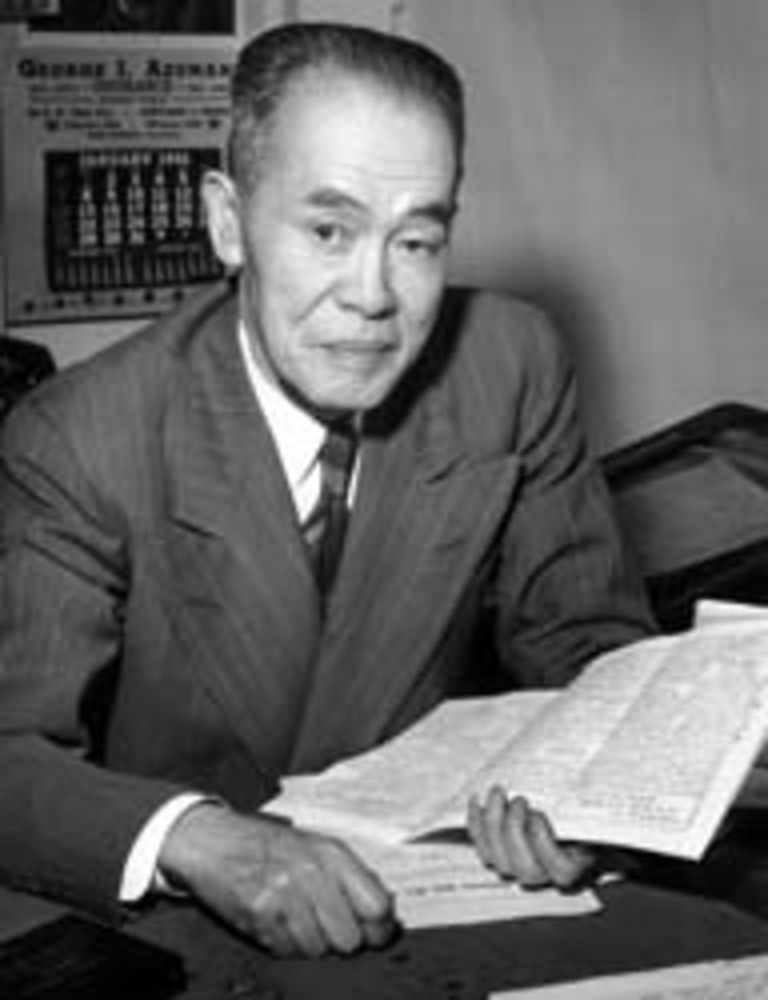For early Japanese immigrants to Oregon, a Japanese-language newspaper was their only contact with the world. In Portland, Shinsaburo Ban was a major labor contractor who placed thousands of men in jobs throughout Oregon, Idaho, and states as far away as Montana and Colorado. His store, located on Northwest Third Avenue and Couch Street, supplied his men with food, clothing, and all the needs for living in remote areas. In 1906, Ban started a private newspaper, called the Oregon Shimpo (Oregon News) to keep in touch with his charges. Many other Japanese who were working on Oregon farms and railroads and for lumber mills relied on Ban and the newspaper to provide what they needed to live in isolation from populated areas.
In 1909, Ban terminated his publishing interests, and the paper was taken over by Toyoji Abe, who changed the name to Oshu Nippo (Oregon Daily News). Six years later, Abe was offered a job in San Francisco, and Iwao Oyama, a fresh face to Oregon, became the editor. Oyama was a journalism major who had graduated from Waseda University in Tokyo before coming to America. With the exception of the war years, he edited the paper for thirty-four years.
The publishing house of Oshu Nippo was located at what is now 131 Northwest Second Avenue, on the street level of the Merchant Hotel. The location housed the editor's office, the printing press, thousands of pieces of Japanese type arranged in compartmentalized trays, and storage for paper. To a young boy, the printing press in the 1930s was a marvelous machine. It was a mechanical marvel designed to conduct a number of synchronized movements in precise succession and end up with multiple copies of printed pages. In spite of its wonders, the machine jammed from time to time and required adjustment by the operator.
Oyama was the primary writer for the paper. In the years preceding World War II, he was assisted by Katsuharu Nakashima, a teacher at the Japanese school in southwest Portland. Each day, articles were written and given to a crew of eight to ten women, who would locate and arrange the typesetting characters and set them onto the printing plate. Considering the thousands of Japanese characters, or kanji, and an additional two sets of phonetic alphabets, setting type was a very busy process and required much dexterity and teamwork. Once the plate was set, the press would run off hundreds of copies for distribution.
If all went well, by four o'clock in the afternoon most of the papers had been labeled for mailing to subscribers and three boys had folded all of the copies and placed them in carrier bags ready to be delivered. One boy delivered papers in the Old Town area, where Japanese businesses were concentrated. Another delivered papers to Japanese businesses that were scattered along the west side of the Willamette River, south to Market Street. The third boy delivered papers to the upper areas of northwest Portland to subscribers scattered in what is now the Pearl District and slightly beyond.
The Oshu Nippo sold for five cents a copy; subscription rates were fifty cents per month and five dollars per year. Much of the income to support the paper was raised through ads and donations.
World War II resulted in harsh experiences for persons of Japanese ancestry in Oregon, and the Oshu Nippo bore its share of drastic changes. On December 7, 1941, the day Pearl Harbor was attacked, federal agents appeared at Oyama's office and took him into immediate custody. The Oshu Nippo came to an abrupt halt, and all of its records and equipment were confiscated, to be used, it was later learned, by the Department of Naval Intelligence to produce propaganda in the Pacific war. Oyama was held by the Department of Justice and incarcerated for the duration of the war in Santa Fe, New Mexico.
When the war ended, the camps closed and Oyama returned to Portland to start a new chapter for the Oshu Nippo. With no opportunity to acquire a press, he started his postwar newspaper with a typewriter and a mimeograph machine. The twice-weekly paper contained two sheets or four pages, with one of the four pages written in English. The paper was produced on the mezzanine level of the T and F Grocery store, located on the southeast corner of Northwest Third Avenue and Davis Street.
The Oshu Nippo finally came to a permanent end in 1952, when Iwao Oyama died. By that time, the Japanese American community was primarily English speaking and a Japanese newspaper was no longer essential. For many decades it had played a vital role in the lives of the immigrant Japanese-speaking population in Oregon and the Pacific Northwest.
-
![]()
Oshu Nippo, January 1, 1918.
Courtesy Oregon Nikkei -
![]()
Iwao Oyama, editor of Oshu Nippo.
Oreg. Hist. Soc. Research Library
Related Entries
-
![Japanese Americans in Oregon]()
Japanese Americans in Oregon
Immigrants from the West Resting in the shade of the Gresham Pioneer C…
-
![Japanese American Wartime Incarceration in Oregon]()
Japanese American Wartime Incarceration in Oregon
Masuo Yasui, together with many members of Hood River’s Japanese commun…
-
![Japantown, Portland (Nihonmachi)]()
Japantown, Portland (Nihonmachi)
Portland's Japantown, or Nihonmachi, is popularly described as having e…
-
![Shinzaburo Ban (1854-1926)]()
Shinzaburo Ban (1854-1926)
Shinzaburo Ban was a Japanese businessman who was instrumental in bring…





